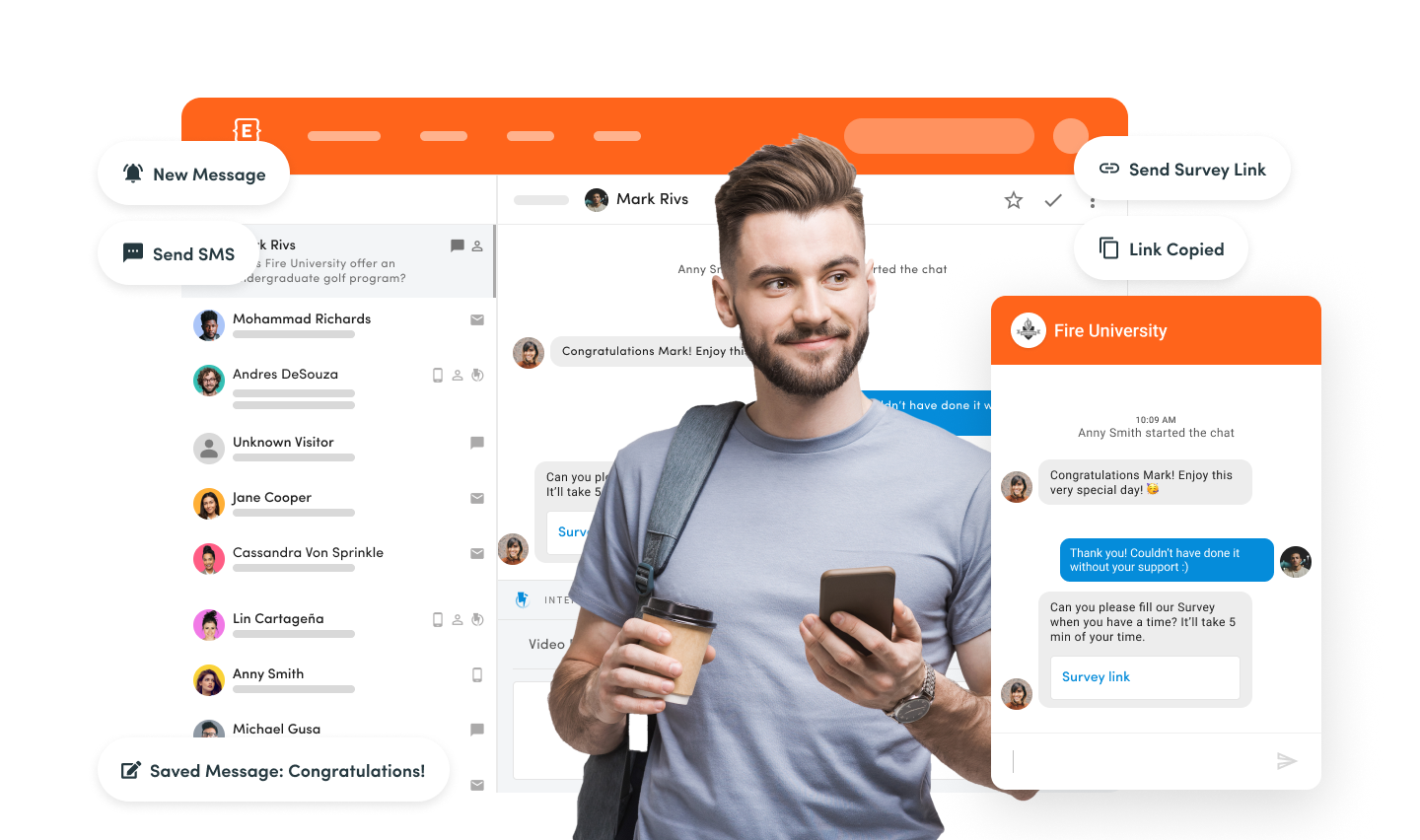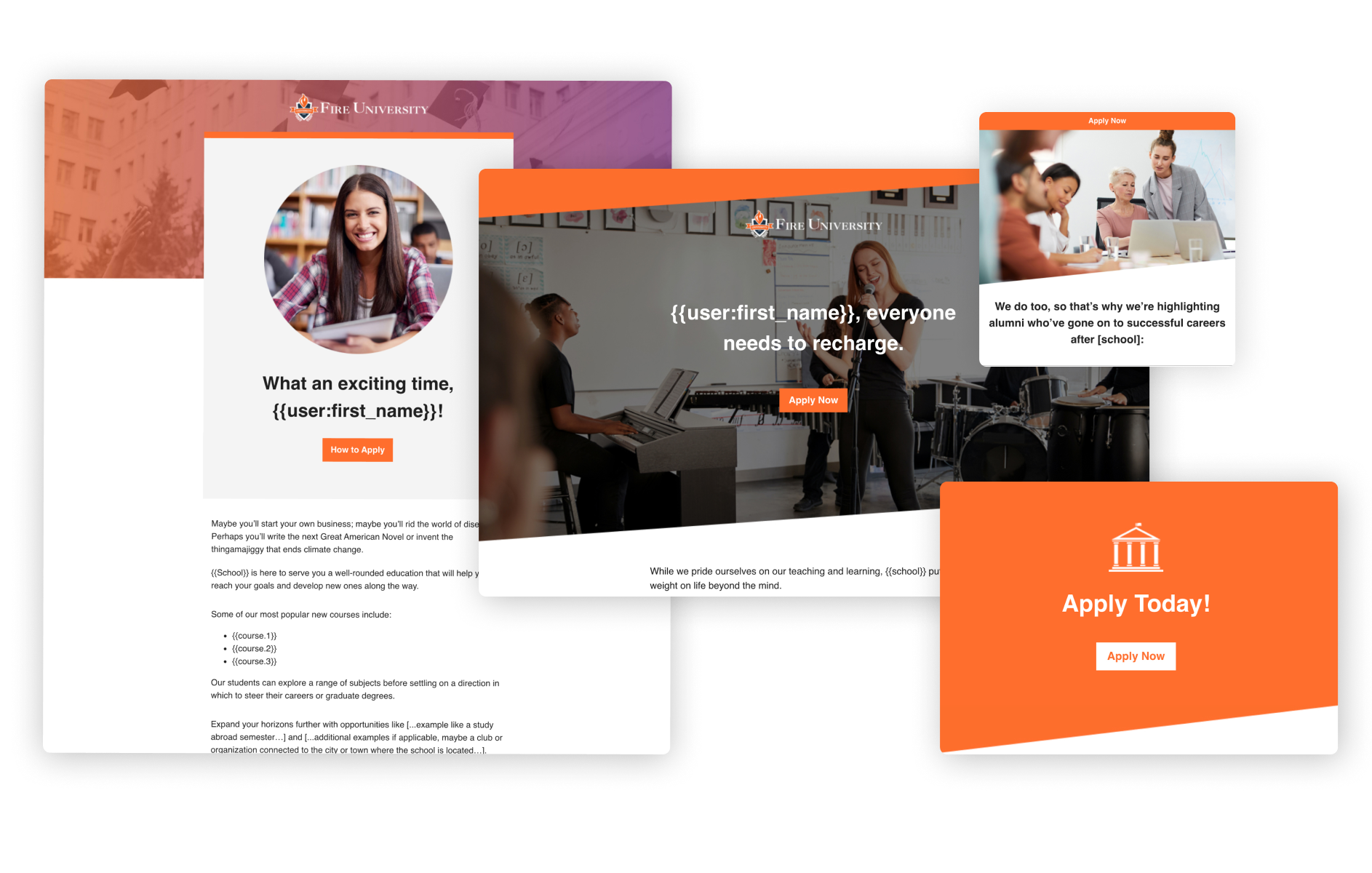4 Ways to Modernize Higher Education Email Marketing
by Sirley Carballo · Updated Mar 17, 2023
How to Keep Your Higher Education Email Marketing Thriving
As a higher-ed admissions marketer, you likely understand how essential email marketing campaigns are to your overall mix. Even in the year we’re in, email continues to be a primary driver of conversions and brand recognition—which could just as easily apply to colleges and universities as it does to businesses. On average, up to 99% of email users check their email at least once per day, which is a level of visibility that you can’t afford to miss.
Now, let’s imagine that you have an email marketing game plan in place. That’s great, but there’s still more that you need to do. In order to keep pace and ensure your email marketing is modern and innovative, you must continually evaluate benchmarks, review and test new scenarios, and stay mindful of the expectations of your current audience.
If your marketing team is aiming to keep emails fresh and relevant, this post is for you. Let’s dive into a few best practices you can start applying to boost your email marketing strategy for the current generation.

Why Do Colleges and Universities Need Email Marketing?
Colleges and universities need email marketing for several reasons. Many of these reasons relate or tie back to a primary goal for teams such as admissions and enrollment. Colleges and universities need email marketing as part of a thriving, scalable marketing plan.
In higher education institutions, email solves a number of different communication needs with any external audience. For admissions and enrollment teams (working on the front lines of student recruitment), the options are nearly endless.
- Distributing general brand information (educational content) to leads
- Reconnecting with prospective students from recruitment fairs or events
- Sending automated communications to potential or current applicants
- Delivering helpful reminders to newly enrolled students
- Connecting with parents, families, and community members, and even current students
As you can see, email marketing is beneficial at nearly every stage of the student lifecycle. Staying in touch and providing practical help are both important factors to the rate of successful enrollment at any college or university.
4 Best Practices for Higher Education Email Marketing
One of the biggest benefits to creating fresh email campaigns is that you can always test and analyze what’s working and what’s not working to attract incoming students. There are several ways that you can give your team’s efforts a leg up when it comes to performance.
Start revamping your university email marketing now by implementing the following tips and best practices. Get ready to see a tangible impact that keeps readers interested!
Tip 1: Make Emails Mobile Friendly
When creating emails for student recruitment, consider how and where a prospective student will be reading your messages. Chances are, it’s not always on a desktop or laptop. By creating email messages that are optimized for mobile devices, you’ll provide a better user experience for prospective students who are on the go or need a convenient way to review messages.
Students in “Gen Z” reportedly look at up to five screens per day, many of which are mobile. As a result, your email campaigns must be able to reach them where they are.
Keep in mind that mobile responsiveness isn’t just about what you say with your email copy. How you display your email campaigns (including the buttons, hyperlinks, and CTAs), can make or break your campaign performance or KPIs within your target audience.
Tip 2: Give Email Marketing Efforts a Personalized Twist
Email messages to university students should sound natural and personable. Instead of approaching students as a number in line for enrollment, marketing teams should speak to them directly as real individuals with needs or questions that are solvable.
Personalization can be a multi-step process that involves simple practices like using the student’s name in communications and only sending out content that’s relevant to where they are on the journey. These small yet powerful tweaks can help your messaging come across as sincere, rather than robotic.
To fully leverage personalization in your email campaigns, you’ll first need reliable student data that you can trust. A student engagement platform can remove the guesswork and empower you to use what you know about each student to connect with them via email.

Get A Demo of Element451
Students explore and pick where they’ll earn a degree in completely new ways. Welcome to the new world of enrollment, powered by Element451. We've been waiting for you.
See It in Action
Tip 3: Always Segment Your Audience
Proper email list segmentation is the process of dividing up your complete email list into separate lists and segments. At a college or university, you should first consider segmenting current from future students. This must be done to ensure that your existing students receive messages that are designed for the internal college community.
Segmentation also involves understanding which part of the process a student is involved in at a given moment. Whether they’re just starting to gather information (top of funnel), or they’ve been accepted to your school and need to provide a decision (bottom of funnel) makes a difference in how and what you say to them.
It’s also clear that segmentation directly connects to personalized emails. The more you know, the more helpful and relevant content you can deliver.
Tip 4: Provide Direction with Subject Line and CTA Improvements
The reality is that many modern students might receive hundreds of emails per day (and some of those get filtered directly to a spam folder). This means that your messages are competing for valuable inbox space. Not only do you need to capture attention, but you also have to provide clear and concise directions with a compelling call to action.
Always incorporate eye-catching and compelling subject lines into your messaging. This practice improves open rate (the number of people who open an email out of all who receive it), and gives the reader an idea of what to expect.
Within the body of the email, make sure the next step is clear. Since most colleges and universities aren’t asking students to make a purchase (like with retail emails), you might have an enrollment step to complete or something for them to submit for registration. Whatever the “ask” might be, remove the hassle from it. Use clear language, buttons, and up-to-date links to make sure that students get where they need to go.

Mistakes to Avoid with Email Marketing for Colleges and Universities
Keeping your email marketing campaign thriving is no small task, but with the right attention to detail, it’s feasible. Savvy higher education marketers can review email content periodically through an audit to better ensure that key changes are made on time.
Additionally, it’s always best to avoid the common traps that can hold schools back from fully optimizing email marketing. Some of the most typical issues with email marketing for higher education might include:
- Ignoring tests – Many email marketers use processes like A/B testing to figure out which version of an email performs better with selected audience members, particularly between future or current students. When you have this data, make sure to apply it in a timely fashion so that your emails have the best chance of succeeding.
- Never evaluating metrics – You might not want to get bogged down by numbers, but having a few benchmarks paves the way for future improvements. Consider data around click-through-rates, open rates, and bounce rates to gauge how your email marketing is performing from year to year.
- Keeping content the same – Depending on how quickly your school applies changes to processes or curriculum, your email updates might be frequent or sporadic. Always apply largescale branding changes to your email messages as soon as you know about them to ensure that branding stays consistent. Employing regular email audits can help you catch simple errors and bring design up to date.

Guide to Choosing a CRM for Higher Ed
Learn what to look for when choosing higher education marketing and enrollment software. This step-by-step plan and requirements template will help you select a higher-ed CRM in weeks, not months.
Download the White Paper
Make Your Higher Education Email Marketing Count
If you’ve been using the same email playbook for years, it’s time to engage existing students and reach new ones with enhanced strategies. While you don’t have to reinvent every aspect of your email marketing strategy, effective teams always look to analyze performance to measure and improve results.
If email marketing is on your list of priorities, you need a well-rounded and innovative CRM platform that allows you to leverage email to its full capacity. Element451 provides the tools and features you need to do just that.
Not a customer year? Don’t worry. You can secure a demo today to get started on your journey to personalized marketing to attract prospective students.

About Element451
Boost enrollment, improve engagement, and support students with an AI workforce built for higher ed. Element451 makes personalization scalable and success repeatable.
Categories
New Blog Posts

The Definitive Guide
AI in Higher Education
Bridge the gap between the latest tech advancements and your institution's success.
Useful Links
Related Articles

Talk With Us
Element451 is the only AI Workforce Platform for higher education. Our friendly experts are here to help you explore how Element451 can improve outcomes for your school.
Get a Demo








